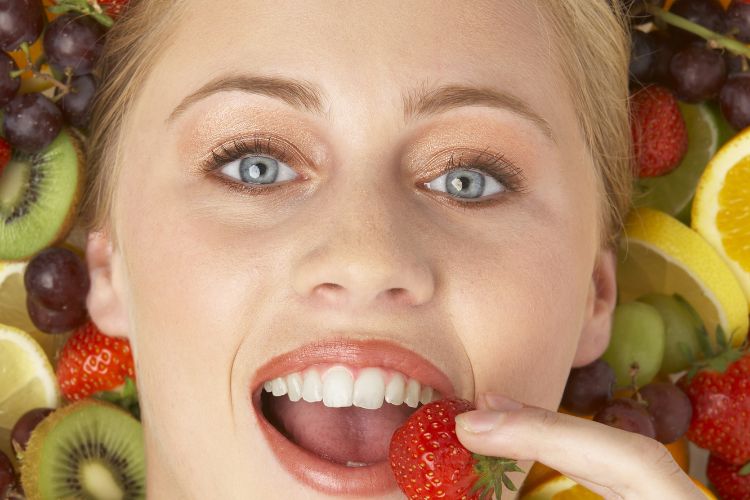Everyone loves a bright, radiant smile – it’s often the first thing people notice and a real confidence booster. While professional whitening treatments can deliver quick results, many people are turning to gentler, more natural ways to maintain or improve the appearance of their teeth. What you eat daily plays a surprisingly big role in how white your teeth look. Some foods can actually help polish your teeth, while others might dull your smile if you’re not careful – especially right after a whitening treatment.
Whether you’re considering teeth whitening or simply looking for everyday tips to keep your teeth looking their best, here’s everything you need to know about food and natural whitening.
Can Certain Foods Help Whiten Your Teeth?
Table of Contents
They absolutely can. Certain fruits, vegetables, and dairy products naturally support oral health and contribute to a cleaner, brighter smile.
Crunchy fruits and vegetables like apples, celery, and carrots are excellent examples. When you chew these fibrous foods, they gently scrub the surface of your teeth, almost like a natural toothbrush. Not only that, but they also help boost saliva production – your mouth’s natural defence against plaque and staining.
Dairy products such as milk, cheese, and yoghurt are also beneficial. They’re rich in calcium and phosphorus, which help to strengthen enamel – the protective outer layer of your teeth. Strong enamel reflects more light and gives teeth a smoother, whiter appearance.
Then there are fruits like strawberries, which contain malic acid – a natural ingredient known to help dissolve surface stains. Pineapple, too, contains bromelain, an enzyme that breaks down plaque and could help in reducing staining over time. These small, daily food choices can make a noticeable difference when included regularly in your diet.
Natural Ways to Support Whitening at Home
If you’re looking to gently whiten your teeth at home, there are a few methods you can try. They won’t deliver dramatic results overnight, but they can contribute to a cleaner and healthier-looking smile over time.
One simple option is oil pulling. This involves swishing a tablespoon of coconut oil around your mouth for about 15–20 minutes, then spitting it out. It’s an ancient practice believed to reduce bacteria, improve gum health, and freshen breath – all of which contribute to a cleaner appearance.
Another method some people try is brushing with a paste made from baking soda and water. Used just once or twice a week, this mildly abrasive mixture can help lift surface stains. It’s important not to overuse it, though – too much baking soda can wear down enamel over time.
Some people also experiment with activated charcoal toothpaste or apple cider vinegar rinses, though these should be used cautiously. While they may have some stain-lifting effects, they can also be harsh on enamel if not used sparingly.
And of course, no matter what remedies you try at home, regular brushing with fluoride toothpaste and flossing daily are essential for long-term oral health.
What to Eat During and After Whitening
If you’ve recently whitened your teeth – whether through professional treatment or home whitening kits – your enamel will be more porous for a day or two. This means your teeth are more likely to absorb pigments from foods and drinks. That’s why dentists often recommend sticking to a “white diet” immediately after whitening.
During this time, it’s best to eat light-coloured, low-acid foods. Think plain yoghurt, mashed potatoes, white rice, cauliflower, bananas, eggs, and skinless chicken. These gentle options won’t stain your teeth or cause irritation.
Hydration is key too. Drinking plenty of water helps rinse away food particles and reduce the chance of staining. If you do have coffee or tea, try to use a straw to limit contact with your teeth, and rinse your mouth with water afterwards.
It’s best to avoid dark or acidic foods and drinks in the first few days after whitening. This includes coffee, red wine, cola, soy sauce, tomato-based sauces, curry, and anything with artificial colouring. Foods that are highly acidic, such as citrus fruits and vinegar, should also be limited during this period as they can weaken enamel and increase sensitivity.
Long-Term Habits for a Whiter Smile
Good daily habits go a long way in keeping your smile bright. Try to brush at least twice a day, floss daily, and rinse with water after eating stain-prone foods or drinks. Staying on top of your oral hygiene not only keeps your teeth looking good, but also supports your overall health.
It’s also worth mentioning that even with the best diet and at-home care, some stains – especially those caused by medication, genetics, or age – can be more stubborn. If you’re finding it difficult to brighten your teeth naturally, or you’re unsure which whitening method is right for you, it’s always a good idea to speak with a dentist. They can help guide you on safe and effective options tailored to your needs, and sometimes just a simple polish at your routine appointment can make a big difference.
You don’t have to rely solely on whitening strips or treatments to enjoy a healthier, more radiant smile. What you eat every day plays a powerful role in the appearance of your teeth. Crunchy vegetables, fresh fruits, and calcium-rich dairy can help gently clean and protect your teeth, while avoiding deeply pigmented or acidic foods – especially after whitening – can preserve your results.
Taking small steps in your daily routine, staying hydrated, and being mindful of your food choices all add up. And remember, if you’re ever unsure, or your teeth aren’t responding the way you’d like, a visit to your dentist is a great place to start.

